
| Photos From Wyoming Tales and Trails This page: Greybull, John Borner, Settlement of the Northern Bighorn Basin, the Bad Pass Trail. |
 |

| Photos From Wyoming Tales and Trails This page: Greybull, John Borner, Settlement of the Northern Bighorn Basin, the Bad Pass Trail. |
 |
|
|
|
About This Site |
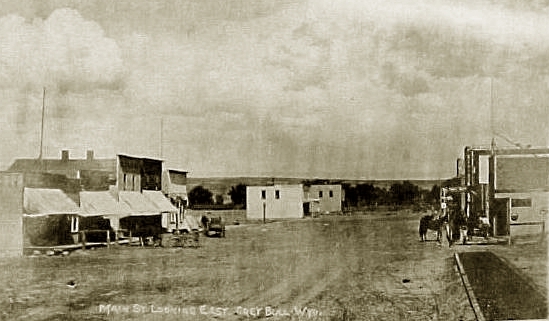 Greybull Ave., looking east, 1909 Greybull, which celebrates it centennial in 2006, is at the confluence of the Bighorn River and the Greybull River, The river is allegedly named after an albino American Bison. The appearance of an albino bison is regarded by the Native Americans of the Northern Great Plains has having great significance. It serves as a reminder, through the legend of White Buffalo Calf Woman, that God, Wakan-Tanka, provides for all our needs.
[Notes: the Seven Sacrements are those of Purification (the Sweat Lodge), Child Naming, Healing, Adoption, Marriage, the Vision Quest, and the Sundance. Other versions of the legend of the White Buffalo Calf Woman exist. In other versions, the brave who had lust in his heart was struck dead by a bolt of lightening from Heaven. In one version, White Buffalo Calf Woman did not transmorph from a white buffalo to human form, but instead, in human form, wore buffalo robes of purest white. The braves recognized that she was wakan; that is, holy, as she was borne above the ground. Wakan-Tanka, the Great Spirit, was originally an amorphous spirit, all about us, and was not in the form of man such as were Zeus or Odin. The parable teaches us that the buffalo was a gift from God.] Another explanation for the naming of the Greybull River is that it was named after a Crow chief. This, however, may be speculative. The name of the river dates back to the 1830's. References to a Crow chief by that name date only to about 1859. Washington Irving in his 1837 The Adventures of Captain Bonneville; or, Scenes beyond the Rocky Mountains of the Far West, based on Benjamin L. E. Bonneville's expedition into the west 1832-1836, indicates that a portion of Bonneville's party travelled to the confluence of the "Gray Bull" and the Bighorn. Stephen Hall Meek in his Autobiograph makes reference to Jim Bridger's brigade being along "Gray Bull River" in 1832. Maps prepared by John C. Fremont's Expeditions, 1842-1845, reflect the existence of the Greybull River and indicate that Fremont ventured into the Basin. Both Kit Carson and Basil Cimineau LaJeunesse acted as guides for Fremont. The Seminoe [an Anglicized variation of Cimineau] Mountains and Reservoir are named after LaJeunesse. LaJeunesse was killed by Indians in Oregon.
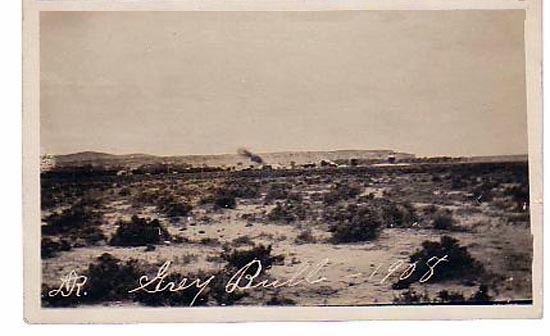 Greybull, 1908
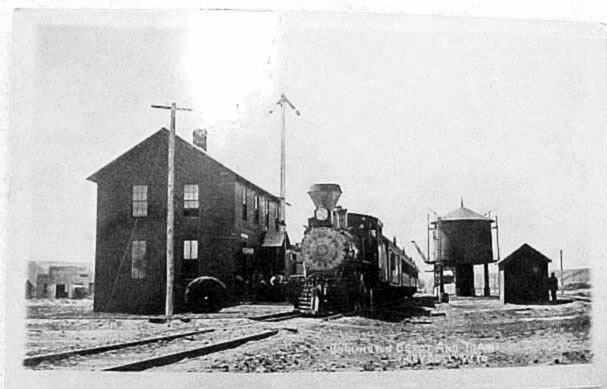 Greybull, 1909 In the northeastern portion of Bighorn County lie the Pryor Mountains named after Nathaniel Pryor who was a member of the Lewis and Clark Expedition which passed to the north. Through these mountains is the Bad Pass Trail used by early mountain men to carry furs from the Bighorn Basin east to the Missouri River. Artifacts found in the pass indicate that the pass has been used for the last 10,000 years. The first European to use the pass was Francois Larocque, a trapper with the British Northwest Company in 1805. The pass was later utilized by the Rocky Mountain Fur Company in 1824 and 1825. In the later year, General William Ashely transported some $50,000 in furs through the pass.
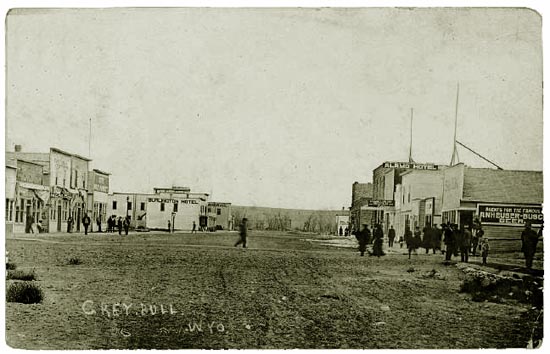 Greybull Ave., looking east, 1911 Notwithstanding early exploration by trappers, the area remained relatively unexplored and certainly unsettled until the late 1870's when Henry Clay Lovell trailed two herds of cattle into the area in 1879. In 1883, Lovell, after whom Lovell, Wyoming is named, in partnership with Anthony L. Mason of Kansas City,established a ranch at the mouth of Nowood Creek, followed by the establishment the following year of a second ranch on Shell Creek. A third ranch was formed at Five Springs which became the headquarters for the operation. At one time the partnership controlled 25,000 head ranging from Thermopolis north into Montana. Other settlers in the area included Josia Cook, first postmaster for Lovell and B. F. Wickwire who homesteaded Medicine Lodge. The first settler in what is now Greybull was John Gottlieb Borner (1838-1919) who came to the area from the Lander area following the death of his wife in 1886.
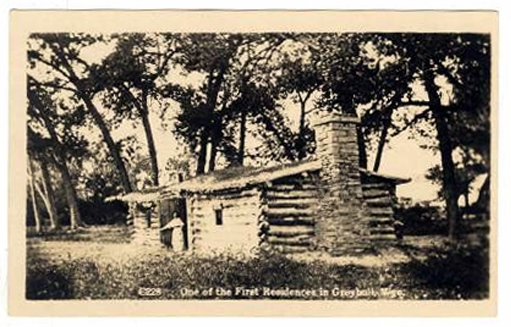 Borner Cabin, Greybull City Park, undated. Note that the cabin appears to be a dog trot and note the sod roof. The far end of the cabin, would typically have been used to house animals. The stable portion of the cabin in the next photo is missing. The cabin was constructed by Borner and J. A. Benjamin of Lander. Today, the chimney remains in the Park. Borner was born in Saxony in what is now Germany. He immigrated to Oak Grove, Wisconsin, in 1859. In 1861, he enlisted in Company "A" of the 12th Wisconsin. He received a medical discharge in 1862. With the gold rush, he was the South Pass area in 1875. At Miner's Delight he broke his leg as a result from a fall from his horse. Through his nurse, Martha Jane "Calamity Jane" Canary, he met Canary's sister Lena whom he married.
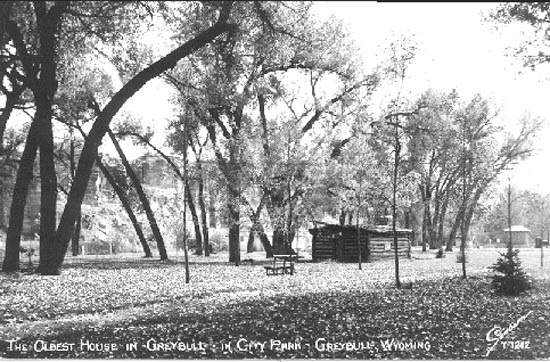 Cabin, Greybull Park, 1940. Borner's cabin was later used as a school house. With the coming of the railraod, Borner sold his homestead to the Lincoln Land Company. Greybull, as a town, dates to the first decade of the 1900's when a combination of the coming of irrigation, the discovery of gas and oil, and the coming of the Chicago, Burlington & Quincy Railroad made the town possible. In 1897, a small group of Mormons settled at Burlington, about 18 miles west of Greybull. Fortuitously, as discussed with regard to Cody, William F. Cody was taking interest in creating an agricultural community on the Stinking Water at what later became Cody. In 1899, Cody and Nate Salisbury, business manager of the Wild West show, obtained approval under the Carey Act to divert irrigation water was from the Stinking Water (renamed the Shoshone River by State Engineer Elwood Mead at the behest of Cody's group).
At the same time, the Church under the leadership of A. O. Woodruff, son of the late president of the Church, and Joseph W. McMurrin had taken an increased interest in the area. Cody, ever short of money, needed to jump start his irrigation project. Thus, in a transaction brokered by Governor DeForest Richards, some of Cody's rights were transferred to the State which in turn assigned them to the Big Horn Colonization Company under control of the Church.
Some 450 additional Mormon settlers were then brought into the area, settling at Byron and Cowley. The Company permitted labor to be exhanged for shares. The project was, however, woefully underfunded. Then, as if in answer to prayers, the Burlington began moving into the area and was in need of workers. Thus, the settlers split into two crews. One-half worked on the canal and the other half worked on the railroad. The railroad workers devoted half their pay for shares in the canal, thus providing sufficient funds to complete the work. The settlers dug the Sidon Canal a distance of 37 miles from its headgate on the Shoshone in two years, aided when a large sandstone boulder, now known as "Prayer Rock", was split by what settlers regarded as answered prayers and divine intervention. But until the canal was completed, conditions in some of the Mormon settlements were less than idealic. Cowley, as an example, was six miles miles from the closest source of water. The canal did not reach it until July 1902, and until then water had to be hauled in. Coincidently, in 1907 gas was discovered in the area. Thus, the combination of irrigation, oil and gas, and the railroad laid the groundwork for the growth of the basin. Yet, in the final analysis, neither Cody nor the Mormons came out as they desired. Cody's lands were essentially ignored with only 6,500 acres under irrigation by 1905 and he became inundated in some 26 different lawsuits over the irrigation. Nor did the Church receive the lands it wanted. The outgrowth was that just about every important politician in the State was sucked into the issue of irrigation in the Big Horn Basin. After Governor Richard's death, Acting Governor Fenimore Chatterton became involved. Also taking part were Senator F. E. Warren, Congressman Frank Mondell, the Burlington Railroad and its chief counsel Charles Manderson, after whom the town is named. Even President Roosevelt was not immune to being continually importuned by Col. Cody as Cody sank ever deeper in debt.
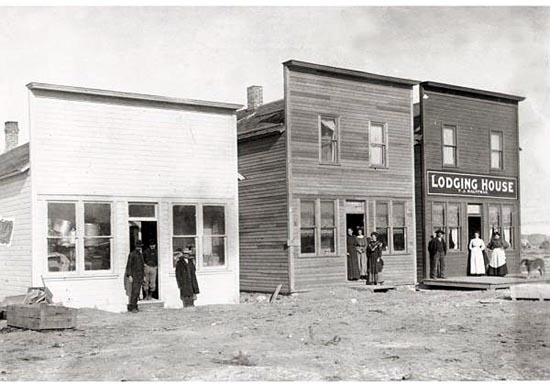 North side Greybull Avenue, 1906 From left to right: The first building is the Pioneer Store owned by Ed Hamilton standing to the left of the doorway. The individual in the coat standing to the right of the door is an unidentified sheepherder. The center building is the City Restuarant owned by Ella Clarinda Boice standing in the doorway with two of her five daughters. Mrs. Boice, her husband Benjamin Franklin Boice, and five daughters, Julie, Maude, Ella, Mary, and Martha, came from Colorado. The Lodging House was owned by Frank. J. Halffman standing in front. The two women are unidentified. Halffman drove a herd of horses into the Basin from Nevada in 1886 and settled along Shell Creek. He was reputedly the second white man along the creek. He proved up his homestead along Shell Creek in 1898.
Next page: Greybull continued. |